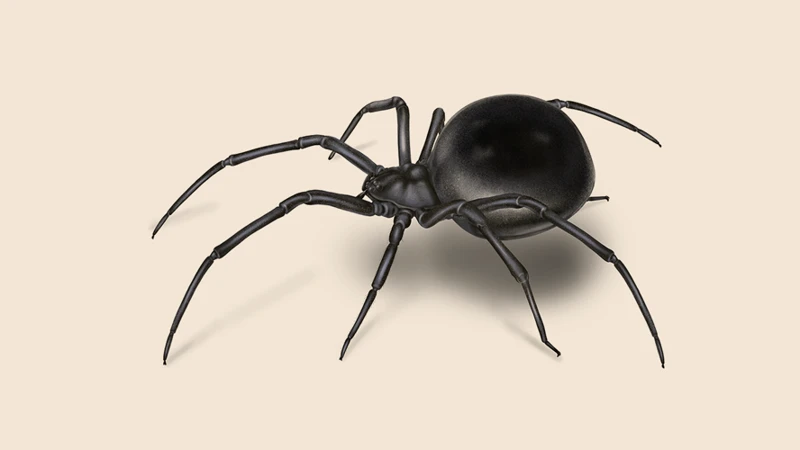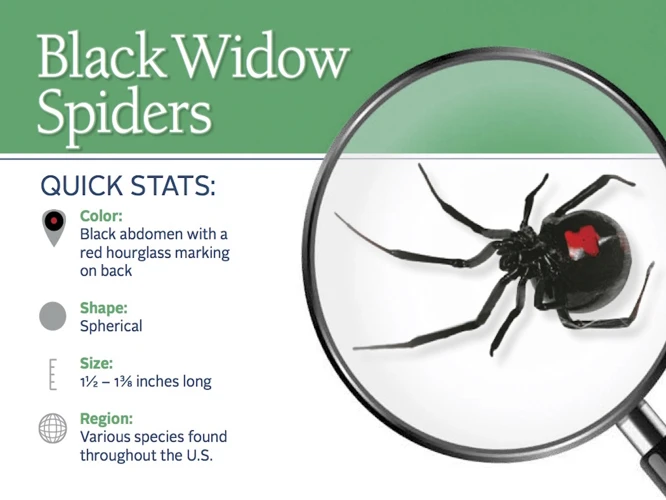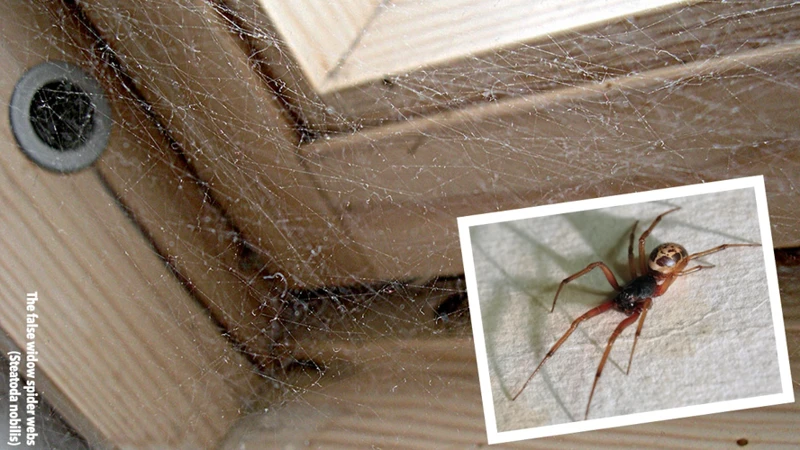As we go about our daily lives, we tend to forget that we share the world with millions of other species. While most of them are harmless, some can pose a threat to us, including the infamous black widow spider. These spiders are among the most venomous in North America, making identifying and avoiding them crucial. One of the most noticeable signs of the presence of black widows is their unique webs. In this article, we’ll show you how to spot black widow spider webs around your home, and what to do if you encounter them. So, if you’re ready to learn about these elusive creatures, grab your magnifying glass, and let’s get started!
Identifying Black Widow Spider Webs

If you live in an area with black widow spiders, it’s important to be able to identify their webs to avoid a potentially dangerous encounter. Black widow spiders prefer quiet, undisturbed areas such as basements, garages, and outdoor debris to build their nests. In this section, we’ll explore the key factors in identifying black widow spider webs to help you stay safe. Keep an eye out for signs of moisture-loving spiders and risk factors associated with them – black widows love damp areas and are typically found in areas with clutter and debris, such as piles of firewood or outdoor debris.
Location and Appearance
Black widow spider webs can be found in a variety of locations, both indoors and outdoors. The webs are typically found in dry, dark areas such as basements, garages, closets, and outdoor sheds. When searching for black widow spider webs, it’s important to look for webs that appear to be disorderly and haphazard. Unlike other spider webs that are neatly organized, black widow spider webs are irregularly shaped and have a tangled appearance.
The webs are usually constructed of strong, sticky silk and are usually small in size, measuring no more than a few inches in diameter. The webs are also often hidden in hard-to-see areas, such as corners and crevices. It’s important to keep an eye out for signs of black widow spider webs, especially if you live in an area where these spiders are common.
If you suspect that you have found a black widow spider web, it’s important to approach it with caution. Black widow spiders are known for their venomous bites, which can be painful and even deadly. To avoid being bitten, it’s important to avoid touching the web or coming into contact with the spider.
To summarize, keep an eye out for small, messy webs in dark, dry areas both indoors and outdoors. If you do spot a web, approach it with caution and take steps to remove it or contact a professional if necessary.
Web Shape and Positioning
Web Shape and Positioning
Black widow spider webs can vary in shape and size depending on the location and availability of webbing materials. The webs are typically irregular in shape and may appear tangled and messy. They are usually located in dark and undisturbed areas, such as basements, closets, crawl spaces, and garages.
The webs may be positioned in areas where prey is likely to be found, such as near light sources, under outdoor furniture, and in piles of yard debris. They may also be found near sources of heat, such as furnaces, fireplaces, and hot water heaters.
To help you identify black widow spider webs, here is a table summarizing their common shape and positioning:
| Web Shape | Web Positioning |
|---|---|
| Irregular and messy | In dark and undisturbed areas |
| Sticky and strong | Near sources of heat |
| Coarse and tangled | Near light sources |
| Silky and smooth | Under outdoor furniture |
Remember, it’s important to exercise caution when identifying black widow spider webs and to avoid touching or disturbing them. If you suspect that you have a black widow spider infestation in your home or yard, take appropriate preventative measures or contact a professional for assistance. For more information on outdoor prevention, check out our article on how to keep black widows out of your yard.
Spider Activity and Behavior
Black Widow spiders typically build their webs in undisturbed areas of the home or yard. They are known to prefer warm, dark, and dry environments and can often be found in places such as garages, sheds, basements, and woodpiles. When trying to identify Black Widow spider webs, it is important to be aware of their behavior and activity.
Spider Activity: Black Widow spiders are nocturnal, which means they are most active during the night and may not be seen during the day. They tend to stay in their webs or hide in dark crevices during the day to avoid predators and conserve their energy. This can make it difficult to spot their webs during daytime hours.
Web building: The black widow spider builds its web in a unique way, making it easily recognizable. Their webs are tightly woven and often have a funnel shape with a messy, irregular web pattern. These spider webs are typically built near the ground or in hard to reach areas like corners, cracks, and crevices.
Web maintenance: Black Widow spiders are known for regularly repairing and rebuilding their webs. This means that if you spot a web in a particular location one day, it may not be there the next. The spider will often consume its old web to regain some of the energy that was used to build it and then build a new web in its place.
It’s important to note that even though the spider might not be visible, their webs are still dangerous. Black Widow spiders are extremely venomous and can cause serious harm to humans and pets. If you suspect that you have found a Black Widow spider web, it’s best to avoid the area and take preventative measures to keep them from returning.
Yard debris and firewood can create the perfect environment for Black Widows to hide, so it’s important to keep your outdoor space clear of clutter and debris.
Preventative Measures for Black Widow Spider Webs

Taking action to prevent the presence of black widow spiders in and around your home is crucial to ensure your safety and the safety of your loved ones. Implementing preventative measures can drastically reduce the likelihood of encountering these venomous pests. In this section, we will discuss some effective strategies for indoor and outdoor prevention of black widow spider webs. By identifying and eliminating the conditions that attract black widows, you can enjoy a safer and stress-free living environment.
Indoor Prevention
Taking steps to prevent black widow spiders from entering your home is a great way to avoid potential encounters with these venomous arachnids. Here are some indoor preventative measures to consider:
| Preventative Measure | Description |
|---|---|
| Seal entrances | Check for any gaps or holes in windows, doors, and screens. Seal them using caulk, weatherstripping or expandable foam. Don’t forget to check for gaps around pipes, electrical wires, and vents. |
| Keep areas clean | Black widow spiders love pile-ups. Make sure to regularly clean and declutter your home, especially in areas where items are stored, such as basements, attics, and garages. |
| Reduce clutter | Reduce clutter in your home and avoid leaving objects on the floor or piled up on top of each other. This includes shoes, laundry, boxes, and other items that can create potential hiding spots for black widow spiders. |
| Use essential oils | Try using essential oils such as peppermint, lavender, and citronella, which have a strong scent that repels spiders. |
| Use spider traps | Consider placing spider traps around areas where you suspect spiders might be entering your home. These sticky traps are designed to capture spiders without harming them, and can help you monitor spider activity in your home. |
By following these preventative measures, you can help keep black widow spiders out of your home and reduce the risk of encountering them. However, if you do find a black widow spider nest inside your home, it’s important to take action to remove them safely.
Outdoor Prevention
When it comes to preventing Black Widow spider webs outside of your home, there are several steps you can take to reduce their presence in your yard or garden. One of the most effective ways of preventing spider activity on outdoor structures is by keeping them free of debris and clutter. This will minimize the hiding spots for spiders and reduce the likelihood of web formation. Here are some other measures you can take to prevent Black Widow spider webs outdoors:
- Keep the area clean: Regularly clean up your yard by removing leaves, twigs, and other debris that can accumulate in your yard.
- Trim bushes and trees: Black Widow spiders love to build their webs in overgrown vegetation. Prune back trees and bushes regularly to avoid providing spiders a place to spin their webs.
- Store firewood and building materials properly: Both firewood and building materials can provide the perfect shelter for spiders to hide and spin their webs.
- Close off access points: Seal up any cracks and holes in your home’s exterior that could serve as an entry point for spiders.
- Use outdoor lighting: Black Widow spiders love dark and humid spaces, so keeping your outdoor lights on can minimize their presence.
By taking these steps, you can reduce the risk of spider infestations in your outdoor living spaces, making them a safer place for you and your family to relax and play. It’s important to remember that prevention is the key to keeping spiders at bay. If you notice any signs of a spider infestation despite your preventative measures, don’t hesitate to contact a professional for assistance.
If you have young children playing outdoors, you may want to take extra precautions to ensure their safety. Check out our article on black widow spider risks during outdoor play for more information on how to keep them safe in your yard.
What to Do If You Find a Black Widow Spider Web
Finding a black widow spider web in or around your home can bring about a feeling of perplexity and uncertainty. While these spiders are not typically aggressive unless provoked, their venomous bite can lead to severe health problems. Consequently, it’s essential to know what to do if you come across a black widow spider web. In this section, we will cover different approaches you can take, including removing spider webs and seeking the assistance of a professional. But first, let’s take a closer look at the signs that indicate a black widow spider infestation. For more information on juvenile black widow spider habits, click here.
Removing Spider Webs
Once you have identified a black widow spider web, it’s important to take the necessary steps to remove it. Wearing gloves is important to ensure your safety as black widow spiders are considered one of the most dangerous spiders in North America. Here are the steps to take for removing spider webs:
- Locate the web: As mentioned before, black widow spider webs are usually in out-of-the-way places, so using a flashlight will help you locate them.
- Get rid of the spider web: Use a long-handled broom to remove the spider web. Brush it down and away from you so that you can ensure the spider will not fall on you.
- Dispose of the web: Place the spider web and any other debris into a plastic bag, seal it, and throw it in a trash can outside. Do not let the spider web remain inside your home.
- Clean the area: After disposing of the spider web, clean the area thoroughly with soap and water to remove any spider webs or spider eggs that may have been laid.
It’s important to remember that removing the web doesn’t guarantee that you have gotten rid of all the black widow spiders. They are experts at hiding, and they can crawl into cracks and crevices that you might not think of. If you are dealing with a large infestation, you may want to consider contacting a professional exterminator for help.
Remember to take preventative measures to help avoid having to remove webs in the future. Regular cleaning and minimizing clutter can help prevent black widow spiders from making a home in and around your property. For example, cleaning out your garage with the help of our handy guide can help prevent black widow spiders from making it their home.
Contacting a Professional
When it comes to removing black widow spider webs, it’s important to take precautions to avoid getting bitten. For those who are uncomfortable with removing the webs themselves, or for situations where there are too many spider webs around the home, it’s best to call in a professional exterminator. These professionals are equipped with the necessary tools and experience to safely remove the spider webs and any spiders that may be lurking nearby.
Here are a few reasons why contacting a professional is the safest choice:
- Black widow spiders are venomous, and their bites can be dangerous to humans and pets. Attempting to remove spider webs on your own can put you at risk for a potentially harmful bite.
- Professional exterminators are trained to identify, locate, and remove black widow spider nests, even in hard-to-reach areas like basements, attics, or crawl spaces. They also have specialized tools to safely remove spider webs and spiders without causing additional damage to your home.
- After removing the spider webs and spiders, a professional exterminator can provide ongoing pest control services to prevent new infestations from occurring. This can give you peace of mind knowing that your home is protected from further spider activity.
Remember, if you do decide to call in a professional:
- Choose a reputable pest control company with experience in removing black widow spiders and other dangerous pests.
- Ask about the methods they use to remove spider webs and spiders, and make sure they are safe and effective.
- Be prepared to vacate your home for a short period of time while the exterminator works. This is usually only necessary if the infestation is severe or if chemical treatments are used.
- Follow the exterminator’s instructions for preventing new spider infestations, such as sealing up cracks and gaps in your home’s exterior.
By following these precautions and contacting a professional exterminator when necessary, you can protect yourself and your home from the dangers of black widow spider webs. And if you’re interested in learning more about juvenile black widow spider habits, or how to identify black widow spider nests in your yard, be sure to check out the related articles on our website.
Link anchor: /juvenile-black-widow-spider-habits/
Conclusion
In conclusion, being aware of the presence of black widow spiders and their webs can help you protect yourself and your family from potential harm. By understanding the identifying characteristics of black widow spider webs, including location, appearance, shape, and positioning, as well as spider behavior and activity, you can take preventative measures both indoors and outdoors to reduce the likelihood of encountering them. However, if you do find a black widow spider web in or around your home, it is important to take appropriate action quickly and safely. While minor infestations can be addressed by removing spider webs or contacting a pest control professional, larger infestations may require more extensive measures. Remember, prevention is key when it comes to black widow spider nests in your yard, basements and other areas of your home. So, stay alert and take appropriate precautions to keep your home and family safe!
Frequently Asked Questions
1. Can black widow spiders live in any region?
No, black widow spiders live mostly in temperate regions throughout the world.
2. Are black widow spiders dangerous?
Yes, their venom can cause severe cramps, muscle pain, and spasms.
3. What is the best way to avoid black widow spider webs?
Keep your home and yard clean and free of debris, caulk or seal any gaps or openings, and minimize clutter.
4. Can black widow spiders kill humans?
While death from a black widow spider bite is rare, in some cases it can happen, especially if the person bitten is a child or has a pre-existing condition.
5. How do black widow spiders build their webs?
Black widow spiders use a combination of silk and sticky threads to create their webs, which they spin in dry, sheltered areas.
6. What do black widow spider webs look like?
Black widow spider webs are usually irregularly shaped and have an entangled, sticky appearance.
7. Are there any natural predators of black widow spiders?
Yes, some bird species, as well as certain wasps and spider-hunting spiders, prey on black widow spiders.
8. What is the lifespan of a black widow spider?
Female black widow spiders can live up to three years, while males usually only live for a few months.
9. Can black widow spider webs cause respiratory problems?
While it is possible for spider webs to trigger allergies and respiratory problems in some people, it is rare and typically only occurs with other spider species like house spiders.
10. Why is it important to seek medical attention if bitten by a black widow spider?
Black widow spider bites can have serious health consequences if left untreated, including muscle damage and even paralysis.






